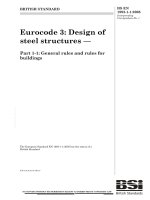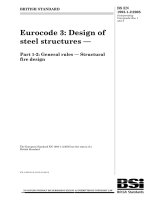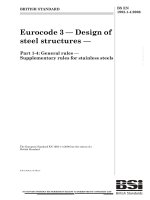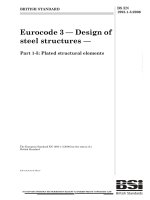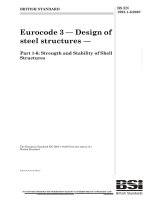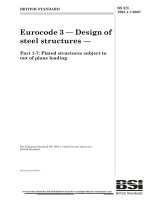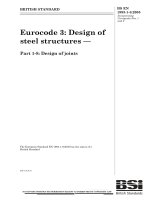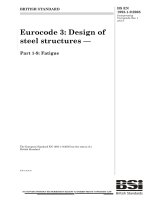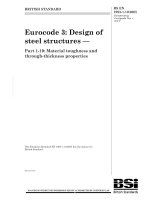Tiêu chuẩn Châu Âu EC9: Kết cấu nhôm phần 1.5: Kết cấu tấm vỏ (Eurocode9 BS EN1999 1 5 e 2007 shell structures Design of aluminum structures part 1.5: Shell structures)
Bạn đang xem bản rút gọn của tài liệu. Xem và tải ngay bản đầy đủ của tài liệu tại đây (672.17 KB, 70 trang )
BRITISH STANDARD
Eurocode 9 — Design
of aluminium
structures —
Licensed copy:PONTYPRIDD COLLEGE, 12/01/2008, Uncontrolled Copy, © BSI
Part 1-5: Shell structures
The European Standard EN 1999-1-5:2006 has the status of a
British Standard
ICS 13.220.50; 91.010.30; 91.080.10
12 &23<,1* :,7+287 %6, 3(50,66,21 (;&(37 $6 3(50,77(' %< &23<5,*+7 /$:
BS EN
1999-1-5:2007
BS EN 1999-1-5:2007
National foreword
This British Standard was published by BSI. It is the UK implementation of
EN 1999-1-5:2007.
The structural Eurocodes are divided into packages by grouping Eurocodes for
each of the main materials, concrete, steel, composite concrete and steel,
timber, masonry and aluminium, this is to enable a common date of
withdrawal (DOW) for all the relevant parts that are needed for a particular
design. The conflicting national standards will be withdrawn at the end of the
coexistence period, after all the EN Eurocodes of a package are available.
Following publication of the EN, there is a period allowed for national
calibration during which the national annex is issued, followed by a further
coexistence period of a maximum 3 years. During the coexistence period
Member States will be encouraged to adapt their national provisions to
withdraw conflicting national rules before the end of the coexistent period in
March 2010.
Licensed copy:PONTYPRIDD COLLEGE, 12/01/2008, Uncontrolled Copy, © BSI
At the end of this coexistence period, the national standard(s) will be
withdrawn.
In the UK, the following national standards are superseded by the Eurocode 9
series. These standards will be withdrawn on a date to be announced.
Eurocode
Superseded British Standards
EN 1999-1-1
BS 8118-2:1991 Structural use of aluminium. Specification
for materials, workmanship and protection (superseded).
DD ENV 1999-1-1:2000 Eurocode 9. Design of aluminium
structures. General rules. General rules and rules for
buildings (superseded).
BS 8118-1:1991 Structural use of aluminium. Code of
practice for design (partially superseded).
EN 1999-1-2
DD ENV 1999-1-2 Design of aluminium structures. General
rules. Structural fire design (superseded).
EN 1999-1-3
DD ENV 1999-2:2000 Eurocode 9. Design of aluminium
structures. Structures susceptible to fatigue (superseded).
BS 8118-1:1991 Structural use of aluminium. Code of
practice for design (partially superseded).
This British Standard was
published under the authority
of the Standards Policy and
Strategy Committee
on 30 March 2007
© BSI 2007
ISBN 978 0 580 50414 3
EN 1999-1-4
BS 8118-1:1991 Structural use of aluminium. Code of
practice for design (partially superseded).
EN 1999-1-5
None
Amendments issued since publication
Amd. No.
Date
Comments
BS EN 1999-1-5:2007
The UK participation in its preparation was entrusted by Technical Committee
B/525, Building and civil engineering structures, to Subcommittee B/525/9,
Structural use of aluminium.
A list of organizations represented on B/525/9 can be obtained on request to its
secretary.
Where a normative part of this EN allows for a choice to be made at the national
level, the range and possible choice will be given in the normative text, and a note
will qualify it as a Nationally Determined Parameter (NDP). NDPs can be a
specific value for a factor, a specific level or class, a particular method or a
particular application rule if several are proposed in the EN.
To enable EN 1999 to be used in the UK, the NDPs will be published in a
National Annex, which will be made available by BSI in due course, after public
consultation has taken place.
This publication does not purport to include all the necessary provisions of a
contract. Users are responsible for its correct application.
Licensed copy:PONTYPRIDD COLLEGE, 12/01/2008, Uncontrolled Copy, © BSI
Compliance with a British Standard cannot confer immunity from legal
obligations.
i
Licensed copy:PONTYPRIDD COLLEGE, 12/01/2008, Uncontrolled Copy, © BSI
blank
EUROPEAN STANDARD
EN 1999-1-5
NORME EUROPÉENNE
EUROPÄISCHE NORM
February 2007
ICS 13.220.50; 91.010.30; 91.080.10
Supersedes ENV 1999-1-1:1998, ENV 1999-1-2:1998,
ENV 1999-2:1998
English Version
Eurocode 9 - Design of aluminium structures - Part 1-5: Shell
structures
Licensed copy:PONTYPRIDD COLLEGE, 12/01/2008, Uncontrolled Copy, © BSI
Eurocode 9 - Calcul des structures en aluminium - Partie 15 : Coques
Eurocode 9 - Bemessung und Konstruktion von
Aluminiumtragwerken - Teil 1-5: Schalen
This European Standard was approved by CEN on 11 October 2006.
CEN members are bound to comply with the CEN/CENELEC Internal Regulations which stipulate the conditions for giving this European
Standard the status of a national standard without any alteration. Up-to-date lists and bibliographical references concerning such national
standards may be obtained on application to the CEN Management Centre or to any CEN member.
This European Standard exists in three official versions (English, French, German). A version in any other language made by translation
under the responsibility of a CEN member into its own language and notified to the CEN Management Centre has the same status as the
official versions.
CEN members are the national standards bodies of Austria, Belgium, Bulgaria, Cyprus, Czech Republic, Denmark, Estonia, Finland,
France, Germany, Greece, Hungary, Iceland, Ireland, Italy, Latvia, Lithuania, Luxembourg, Malta, Netherlands, Norway, Poland, Portugal,
Romania, Slovakia, Slovenia, Spain, Sweden, Switzerland and United Kingdom.
EUROPEAN COMMITTEE FOR STANDARDIZATION
COMITÉ EUROPÉEN DE NORMALISATION
EUROPÄISCHES KOMITEE FÜR NORMUNG
Management Centre: rue de Stassart, 36
© 2007 CEN
All rights of exploitation in any form and by any means reserved
worldwide for CEN national Members.
B-1050 Brussels
Ref. No. EN 1999-1-5:2007: E
EN 1999-1-5:2007 (E)
Content
Page
Foreword .......................................................................................................................................................... 5
National Annex for EN 1999-1-5 .................................................................................................................... 7
1
General ..................................................................................................................................................... 8
1.1
Scope ................................................................................................................................................. 8
1.1.1
Scope of EN 1999...................................................................................................................... 8
1.1.2
Scope of EN 1999-1-5 ............................................................................................................... 8
1.2
Normative references......................................................................................................................... 9
1.3
Terms and definitions ...................................................................................................................... 10
1.3.1
Structural forms and geometry ................................................................................................ 10
1.3.2
Special definitions for buckling calculations........................................................................... 11
1.4
Symbols ........................................................................................................................................... 12
1.5
Sign conventions ............................................................................................................................. 15
1.6
Coordinate systems.......................................................................................................................... 15
Licensed copy:PONTYPRIDD COLLEGE, 12/01/2008, Uncontrolled Copy, © BSI
2
Basis of design ........................................................................................................................................ 17
2.1
2.2
3
General ............................................................................................................................................ 17
Consequence class and execution class ........................................................................................... 17
Materials and geometry ........................................................................................................................ 17
3.1
3.2
3.3
Material properties........................................................................................................................... 17
Design values of geometrical data................................................................................................... 17
Geometrical tolerances and geometrical imperfections................................................................... 18
4
Durability ............................................................................................................................................... 18
5
Structural analysis................................................................................................................................. 18
5.1
5.2
5.3
5.4
5.5
6
Geometry ......................................................................................................................................... 18
Boundary conditions........................................................................................................................ 19
Actions and environmental influences ............................................................................................ 19
Stress resultants and stresses ........................................................................................................... 20
Types of analysis ............................................................................................................................. 20
Ultimate limit state ................................................................................................................................ 21
6.1
Resistance of cross section .............................................................................................................. 21
6.1.1
Design values of stresses ......................................................................................................... 21
6.1.2
Design values of resistance...................................................................................................... 22
6.1.3
Stress limitation ....................................................................................................................... 22
6.1.4
Design by numerical analysis .................................................................................................. 22
6.2
Buckling resistance.......................................................................................................................... 23
6.2.1
General .................................................................................................................................... 23
6.2.2
Buckling-relevant geometrical tolerances ............................................................................... 24
6.2.3
Shell in compression and shear ............................................................................................... 25
6.2.4
Effect of welding ..................................................................................................................... 27
6.2.5
Design by numerical analysis .................................................................................................. 30
7
Serviceability limit states ...................................................................................................................... 31
7.1
7.2
General ............................................................................................................................................ 31
Deflections....................................................................................................................................... 31
Annex A [normative] - Expressions for shell buckling analysis ................................................................ 32
A.1
Unstiffened cylindrical shells of constant wall thickness ............................................................... 32
A.1.1
Notations and boundary conditions ............................................................................................. 32
A.1.2
Meridional (axial) compression................................................................................................... 32
A.1.2.1
Critical meridional buckling stresses................................................................................... 32
2
EN 1999-1-5:2007 (E)
A.1.2.2
Meridional buckling parameter............................................................................................ 33
A.1.3
Circumferential (hoop) compression ........................................................................................... 34
A.1.3.1
Critical circumferential buckling stresses............................................................................ 34
A.1.3.2
Circumferential buckling parameter .................................................................................... 35
A.1.4
Shear ............................................................................................................................................ 37
A.1.4.1
Critical shear buckling stresses............................................................................................ 37
A.1.4.2
Shear buckling parameters................................................................................................... 38
A.1.5
Meridional (axial) compression with coexistent internal pressure .............................................. 38
A.1.5.1
Pressurised critical meridional buckling stress.................................................................... 38
A.1.5.2
Pressurised meridional buckling parameters ....................................................................... 38
A.1.6
Combinations of meridional (axial) compression, circumferential (hoop) compression and shear
39
Licensed copy:PONTYPRIDD COLLEGE, 12/01/2008, Uncontrolled Copy, © BSI
A.2
Unstiffened cylindrical shells of stepwise wall thickness................................................................ 40
A.2.1
General ........................................................................................................................................ 40
A.2.1.1
Notations and boundary conditions ..................................................................................... 40
A.2.1.2
Geometry and joint offsets .................................................................................................. 41
A.2.2
Meridional (axial) compression................................................................................................... 41
A.2.3
Circumferential (hoop) compression ........................................................................................... 41
A.2.3.1
Critical circumferential buckling stresses............................................................................ 41
A.2.3.2
Buckling strength verification for circumferential compression ......................................... 44
A.2.4
Shear ............................................................................................................................................ 44
A.2.4.1
Critical shear buckling stress............................................................................................... 44
A.2.4.2
Buckling strength verification for shear .............................................................................. 45
A.3
Unstiffened lap jointed cylindrical shells......................................................................................... 45
A.3.1
General ........................................................................................................................................ 45
A.3.1.1
Definitions ........................................................................................................................... 45
A.3.1.2
Geometry and stress resultants ............................................................................................ 45
A.3.2
Meridional (axial) compression................................................................................................... 45
A.3.3
Circumferential (hoop) compression ........................................................................................... 45
A.3.4
Shear ............................................................................................................................................ 46
A.4
Unstiffened conical shells .................................................................................................................. 46
A.4.1
General ........................................................................................................................................ 46
A.4.1.1
Notation ............................................................................................................................... 46
A.4.1.2
Boundary conditions............................................................................................................ 46
A.4.1.3
Geometry ............................................................................................................................. 47
A.4.2
Design buckling stresses.............................................................................................................. 47
A.4.2.1
Equivalent cylinder.............................................................................................................. 47
A.4.3
Buckling strength verification ..................................................................................................... 47
A.4.3.1
Meridional compression ...................................................................................................... 47
A.4.3.2
Circumferential (hoop) compression ................................................................................... 48
A.4.3.3
Shear and uniform torsion ................................................................................................... 48
A.5
Stiffened cylindrical shells of constant wall thickness.................................................................... 48
A.5.1
General ........................................................................................................................................ 48
A.5.2
Isotropic walls with meridional stiffeners ................................................................................... 48
A.5.2.1
General ................................................................................................................................ 48
A.5.2.2
Meridional (axial) compression........................................................................................... 49
A.5.2.3
Circumferential (hoop) compression ................................................................................... 49
A.5.2.4
Shear .................................................................................................................................... 49
A.5.3
Isotropic walls with circumferential stiffeners ............................................................................ 50
A.5.4
Circumferentially corrugated walls with meridional stiffeners ................................................... 50
A.5.4.1
General ................................................................................................................................ 50
A.5.4.2
Axial compression ............................................................................................................... 51
A.5.4.3
Stiffened wall treated as carrying axial compression only in the stiffeners ........................ 52
A.5.4.4
Circumferential (hoop) compression ................................................................................... 53
3
EN 1999-1-5:2007 (E)
A.5.5
Axially corrugated walls with ring stiffeners .............................................................................. 53
A.5.5.1
General ................................................................................................................................ 53
A.5.5.2
Axial compression ............................................................................................................... 54
A.5.5.3
Circumferential (hoop) compression ................................................................................... 54
A.5.6
Stiffened wall treated as an orthotropic shell .............................................................................. 54
A.5.6.1
General ................................................................................................................................ 54
A.5.6.2
Axial compression ............................................................................................................... 55
A.5.6.3
Circumferential (hoop) compression ................................................................................... 56
A.5.6.4
Shear .................................................................................................................................... 56
A.5.7
Equivalent orthotropic properties of corrugated sheeting............................................................ 57
A.6
Unstiffened spherical shells under uniform circumferential compression................................... 58
A.6.1
A.6.2
A.6.3
Notations and boundary conditions ............................................................................................. 58
Critical buckling stresses ............................................................................................................. 59
Circumferential buckling parameter ............................................................................................ 59
Licensed copy:PONTYPRIDD COLLEGE, 12/01/2008, Uncontrolled Copy, © BSI
Annex B [informative] - Expressions for buckling analysis of toriconical and torispherical shells....... 60
B.1
General ............................................................................................................................................ 60
B.2
Notations and boundary conditions ................................................................................................. 60
B.3
External pressure ............................................................................................................................. 61
B.3.1
Critical external pressure ......................................................................................................... 61
B.3.2
Uniform squash limit external pressure................................................................................... 62
B.3.3
External pressure buckling parameter ..................................................................................... 63
B.4
Internal pressure .............................................................................................................................. 63
B.4.1
Critical internal pressure.......................................................................................................... 63
B.4.2
Uniform squash limit internal pressure.................................................................................... 64
B.4.3
Internal pressure buckling parameter....................................................................................... 65
4
EN 1999-1-5:2007 (E)
Foreword
This European Standard (EN 1999-1-5:2007) has been prepared by Technical Committee CEN/TC250 «
Structural Eurocodes », the secretariat of which is held by BSI.
This European Standard shall be given the status of a national standard, either by publication of an identical
text or by endorsement, at the latest by August 2007, and conflicting national standards shall be withdrawn at
the latest by March 2010.
This European Standard supersedes ENV 1999-1-1:1998, ENV 1999-1-2:1998 and ENV 1999-2:1998.
CEN/TC 250 is responsible for all Structural Eurocodes.
According to the CEN/CENELEC Internal Regulations, the national standards organizations of the following
countries are bound to implement this European Standard:
Licensed copy:PONTYPRIDD COLLEGE, 12/01/2008, Uncontrolled Copy, © BSI
Austria, Bulgaria, Belgium, Cyprus, Czech Republic, Denmark, Estonia, Finland, France, Germany, Greece,
Hungary, Iceland, Ireland, Italia, Latvia, Lithuania, Luxemburg, Malta, Netherlands, Norway, Poland,
Portugal, Romania, Slovakia, Slovenia, Spain, Sweden, Switzerland and the United Kingdom
Background of the Eurocode programme
In 1975, the Commission of the European Community decided on an action programme in the field of
construction, based on article 95 of the Treaty. The objective of the programme was the elimination of
technical obstacles to trade and the harmonisation of technical specifications.
Within this action programme, the Commission took the initiative to establish a set of harmonised technical
rules for the design of construction works, which, in a first stage, would serve as an alternative to the
national rules in force in the Member States and, ultimately, would replace them.
For fifteen years, the Commission, with the help of a Steering Committee with Representatives of Member
States, conducted the development of the Eurocodes programme, which led to the first generation of
European codes in the 1980s.
In 1989, the Commission and the Member States of the EU and EFTA decided, on the basis of an agreement1
between the Commission and CEN, to transfer the preparation and the publication of the Eurocodes to the
CEN through a series of Mandates, in order to provide them with a future status of European Standard (EN).
This links de facto the Eurocodes with the provisions of all the Council’s Directives and/or Commission’s
Decisions dealing with European standards (e.g. the Council Directive 89/106/EEC on construction products
- CPD - and Council Directives 93/37/EEC, 92/50/EEC and 89/440/EEC on public works and services and
equivalent EFTA Directives initiated in pursuit of setting up the internal market).
The Structural Eurocode programme comprises the following standards generally consisting of a number of
Parts:
EN 1990
EN 1991
EN 1992
EN 1993
EN 1994
EN 1995
EN 1996
EN 1997
EN 1998
EN 1999
1
Eurocode 0:
Eurocode 1:
Eurocode 2:
Eurocode 3:
Eurocode 4:
Eurocode 5:
Eurocode 6:
Eurocode 7:
Eurocode 8:
Eurocode 9:
Basis of Structural Design
Actions on structures
Design of concrete structures
Design of steel structures
Design of composite steel and concrete structures
Design of timber structures
Design of masonry structures
Geotechnical design
Design of structures for earthquake resistance
Design of aluminium structures
Agreement between the Commission of the European Communities and the European Committee for Standardisation (CEN) concerning the work
on EUROCODES for the design of building and civil engineering works (BC/CEN/03/89).
5
EN 1999-1-5:2007 (E)
Eurocode standards recognise the responsibility of regulatory authorities in each Member State and have
safeguarded their right to determine values related to regulatory safety matters at national level where these
continue to vary from State to State.
Status and field of application of Eurocodes
The Member States of the EU and EFTA recognise that Eurocodes serve as reference documents for the
following purposes:
as a means to prove compliance of building and civil engineering works with the essential
requirements of Council Directive 89/106/EEC, particularly Essential Requirement No.1 – Mechanical
resistance and stability, and Essential Requirement No 2 – Safety in case of fire
as a basis for specifying contracts for the execution of construction works and related engineering
services
as a framework for drawing up harmonised technical specifications for construction products (En’s
and ETA’s)
Licensed copy:PONTYPRIDD COLLEGE, 12/01/2008, Uncontrolled Copy, © BSI
The Eurocodes, as far as they concern the construction works themselves, have a direct relationship with the
Interpretative Documents2 referred to in Article 12 of the CPD, although they are of a different nature from
harmonised product standards3. Therefore, technical aspects arising from the Eurocodes work need to be
adequately considered by CEN Technical Committees and/or EOTA Working Groups working on product
standards with a view to achieving full compatibility of these technical specifications with the Eurocodes.
The Eurocode standards provide common structural design rules for everyday use for the design of whole
structures and component products of both a traditional and an innovative nature. Unusual forms of construction or design conditions are not specifically covered and additional expert consideration will be required by
the designer in such cases.
National standards implementing Eurocodes
The National Standards implementing Eurocodes will comprise the full text of the Eurocode (including any
annexes), as published by CEN, which may be preceded by a National title page and National foreword, and
may be followed by a National annex [informative].
The National Annex (informative) may only contain information on those parameters which are left open in
the Eurocode for national choice, known as Nationally Determined Parameters, to be used for the design of
buildings and civil engineering works to be constructed in the country concerned, i.e. :
– values for partial factors and/or classes where alternatives are given in the Eurocode;
– values to be used where a symbol only is given in the Eurocode;
– geographical and climatic data specific to the Member State, e.g. snow map;
– the procedure to be used where alternative procedures are given in the Eurocode;
– references to non-contradictory complementary information to assist the user to apply the Eurocode.
Links between Eurocodes and harmonised technical specifications (EN’s and ETA’s) for
products
There is a need for consistency between the harmonised technical specifications for construction products
and the technical rules for works4. Furthermore, all the information accompanying the CE Marking of the
construction products, which refer to Eurocodes, shall clearly mention which Nationally Determined Parameters have been taken into account.
2
According to Art. 3.3 of the CPD, the essential requirements (ERs) shall be given concrete form in interpretative documents for the creation of the
necessary links between the essential requirements and the mandates for harmonised ENs and ETAGs/ETAs.
3
According to Art. 12 of the CPD the interpretative documents shall :
a) give concrete form to the essential requirements by harmonising the terminology and the technical bases and indicating classes or
levels for each requirement where necessary ;
b) indicate methods of correlating these classes or levels of requirement with the technical specifications, e.g. methods of calculation
and of proof, technical rules for project design, etc. ;
c) serve as a reference for the establishment of harmonised standards and guidelines for European technical approvals.
The Eurocodes, de facto, play a similar role in the field of the ER 1 and a part of ER 2.
4
see Art.3.3 and Art.12 of the CPD, as well as clauses 4.2, 4.3.1, 4.3.2 and 5.2 of ID 1.
6
EN 1999-1-5:2007 (E)
National Annex for EN 1999-1-5
This European Standard gives alternative procedures, values and recommendations for classes with notes
indicating where national choices may have to be made. Therefore the National Standard implementing EN
1999-1-5 should have a National Annex containing all Nationally Determined Parameters to be used for the
design of aluminium shell structures to be constructed in the relevant country.
Licensed copy:PONTYPRIDD COLLEGE, 12/01/2008, Uncontrolled Copy, © BSI
National choice is allowed in EN 1999-1-5 through clauses:
–
2.1 (3)
–
2.1 (4)
7
EN 1999-1-5:2007 (E)
1 General
1.1 Scope
1.1.1
Scope of EN 1999
(1)P EN 1999 applies to the design of buildings and civil engineering and structural works in aluminium. It
complies with the principles and requirements for the safety and serviceability of structures, the basis of their
design and verification that are given in EN 1990 – Basis of structural design.
(2)P EN 1999 is only concerned with requirements for resistance, serviceability, durability and fire resistance of aluminium structures. Other requirements, e.g. concerning thermal or sound insulation, are not
considered.
Licensed copy:PONTYPRIDD COLLEGE, 12/01/2008, Uncontrolled Copy, © BSI
(3)
EN 1999 is intended to be used in conjunction with:
–
EN 1990
Basis of structural design
–
EN 1991
Actions on structures
–
European Standards for construction products relevant for aluminium structures
–
EN 1090-1
Execution of steel structures and aluminium structures – Part 1: Requirements for
conformity assessment of structural components5
–
EN 1090-3
Execution of steel structures and aluminium structures – Part 3: Technical requirements
for aluminium structures5
(4)
EN 1999 is subdivided in five parts:
EN 1999-1-1
Design of Aluminium Structures: General structural rules.
EN 1999-1-2
Design of Aluminium Structures: Structural fire design.
EN 1999-1-3
Design of Aluminium Structures: Structures susceptible to fatigue.
EN 1999-1-4
Design of Aluminium Structures: Cold-formed structural sheeting.
EN 1999-1-5
Design of Aluminium Structures: Shell structures.
1.1.2
Scope of EN 1999-1-5
(1)P EN 1999-1-5 applies to the structural design of aluminium structures, stiffened and unstiffened, that
have the form of a shell of revolution or of a round panel in monocoque structures.
(2) The relevant parts of EN 1999 should be followed for specific application rules for structural design.
(3) Supplementary information for certain types of shells are given in EN 1993-1-6 and the relevant
application parts which include:
- Part 3-1 for towers and masts;
- Part 3-2 for chimneys;
- Part 4-1 for silos;
- Part 4-2 for tanks;
- Part 4-3 for pipelines.
(4) The provisions in EN 1999-1-5 apply to axisymmetric shells (cylinders, cones, spheres) and associated
circular or annular plates and beam section rings and stringer stiffeners where they form part of the complete
structure.
5 To be published
8
EN 1999-1-5:2007 (E)
(5) Single shell panels (cylindrical, conical or spherical) are not explicitly covered by EN 1999-1-5.
However, the provisions can be applicable if the appropriate boundary conditions are duly taken into
account.
(6) Types of shell walls covered in EN 1999-1-5 can be, see Figure 1.1:
- shell wall constructed from flat rolled sheet, termed ‘isotropic’;
- shell wall with lap joints formed by connecting adjacent plates with overlapping sections, termed ‘lapjointed;
- shell wall with stiffeners attached to the outside, termed ‘externally stiffened’ irrespective of the spacing
of the stiffeners;
- shell wall with the corrugations running up the meridian, termed ‘axially corrugated’;
Licensed copy:PONTYPRIDD COLLEGE, 12/01/2008, Uncontrolled Copy, © BSI
- shell wall constructed from corrugated sheets with the corrugations running around the shell circumference, termed ‘circumferentially corrugated’.
Elevation
Plan
Isotropic
(unstiffened)
lap-jointed
externally
stiffened
axially
corrugated
circumferentially
corrugated
Figure 1.1 - Illustration of cylindrical shell forms
(7) The provisions of EN 1999-1-5 are intended to be applied within the temperature range defined in EN
1999-1-1. The maximum temperature is restricted so that the influence of creep can be neglected. For
structures subject to elevated temperatures associated with fire see EN 1999-1-2.
(8) EN 1999-1-5 does not cover the aspects of leakage.
1.2 Normative references
(1) EN 1999-1-5 incorporates by dated or undated reference, provisions from other publications. These
normative references are cited at the appropriate places in the text and the publications are listed hereafter.
For dated references, subsequent amendments to or revisions of any of these publications apply to this
European Standard only if incorporated in it by amendment or revision. For undated references the latest
edition of the publication referred to applies (including amendments).
EN 1090-1 Execution of steel structures and aluminium structures – Part 1: Requirements for conformity
assessment of structural components5
EN 1090-3 Execution of steel structures and aluminium structures – Part 3: Technical requirements for
aluminium structures5
9
EN 1999-1-5:2007 (E)
EN 1990
Basis of structural design
EN 1991
Actions on structures – All parts
EN 1993-1-6
Design of steel structures - Part 1-6: Shell structures
EN 1993-3-2
Design of steel structures - Part 3-2: Chimneys
EN 1993-4-1
Design of steel structures - Part 4-1: Silos
EN 1993-4-2
Design of steel structures - Part 4-2: Tanks
EN 1993-4-3
Design of steel structures - Part 4-3: Pipelines
EN 1999-1-1
Design of aluminium structures - Part 1-1: General rules
EN 1999-1-2
Design of aluminium structures - Part 1-2: Structural fire design
EN 1999-1-3
Design of aluminium structures - Part 1-3: Structures susceptible to fatigue
EN 1999-1-4
Design of aluminium structures - Part 1-4: Cold-formed structural sheeting
1.3 Terms and definitions
Licensed copy:PONTYPRIDD COLLEGE, 12/01/2008, Uncontrolled Copy, © BSI
(1) Supplementary to EN 1999-1-1, for the purposes of this part, the following definitions apply:
1.3.1
Structural forms and geometry
1.3.1.1
shell
A thin-walled body shaped as a curved surface with the thickness measured normal to the surface being
small compared to the dimensions in the other directions. A shell carries its loads mainly by membrane
forces. The middle surface may have finite radius of curvature at each point or infinite curvature in one
direction, e.g. cylindrical shell.
In EN 1999-1-5, a shell is a structure or a structural component formed from curved sheets or extrusions.
1.3.1.2
shell of revolution
A shell composed of a number of parts, each of which is a complete axisymmetric shell.
1.3.1.3
complete axisymmetric shell
A shell whose form is defined by a meridional generator line rotated around a single axis through 2π radians.
The shell can be of any length.
1.3.1.4
shell segment
A part of shell of revolution in the form of a defined shell geometry with a constant wall thickness: a
cylinder, conical frustum, spherical frustum, annular plate or other form.
1.3.1.5
shell panel
An incomplete axisymmetric shell: the shell form is defined by a rotation of the generator about the axis
through less than 2π radians.
1.3.1.6
middle surface
The surface that lies midway between the inside and outside surfaces of the shell at every point. If the shell is
stiffened on only one surface, the reference middle surface is still taken as the middle surface of the curved
shell plate. The middle surface is the reference surface for analysis, and can be discontinuous at changes of
thickness or shell junctions, leading to eccentricities that are important to the shell response.
10
EN 1999-1-5:2007 (E)
1.3.1.7
junction
The point at which two or more shell segments meet: it can include a stiffener or not: the point of attachment
of a ring stiffener to the shell may be treated as a junction.
1.3.1.8
stringer stiffener
A local stiffening member that follows the meridian of the shell, representing a generator of the shell of
revolution. It is provided to increase the stability, or to assist with the introduction of local loads. It is not
intended to provide a primary resistance for bending due to transverse loads.
Licensed copy:PONTYPRIDD COLLEGE, 12/01/2008, Uncontrolled Copy, © BSI
1.3.1.9
rib
A local member that provides a primary load carrying path for bending down the meridian of the shell,
representing a generator of the shell of revolution. It is used to transfer or distribute transverse loads by
bending.
1.3.1.10
ring stiffener
A local stiffening member that passes around the circumference of the shell of revolution at a given point on
the meridian. It is assumed to have no stiffness in the meridional plane of the shell. It is provided to increase
the stability or to introduce axisymmetric local loads acting in the plane of the ring by a state of
axisymmetric normal forces. It is not intended to provide primary resistance for bending.
1.3.1.11
base ring.
A structural member that passes around the circumference of the shell of revolution at the base and provides
means of attachment of the shell to a foundation or other element. It is needed to ensure that the assumed
boundary conditions are achieved in practice.
1.3.2
Special definitions for buckling calculations
1.3.2.1
critical buckling load
The smallest bifurcation or limit load determined assuming the idealised conditions of elastic material
behaviour, perfect geometry, perfect load application, perfect support, material isotropy and absence of
residual stresses (LBA analysis).
1.3.2.2
critical buckling stress
The nominal membrane stress associated with the elastic critical buckling load.
1.3.2.3
characteristic buckling stress
The nominal membrane stress associated with buckling in the presence of inelastic material behaviour and of
geometrical and structural imperfections.
1.3.2.4
design buckling stress
The design value of the buckling stress, obtained by dividing the characteristic buckling stress by the partial
factor for resistance.
1.3.2.5
key value of the stress
The value of stress in a non-uniform stress field that is used to characterise the stress magnitude in the buckling limit state assessment.
11
EN 1999-1-5:2007 (E)
1.3.2.6
tolerance class
The class of requirements to geometrical tolerances for work execution.
NOTE Geometrical tolerances for work execution are built up from fabrication of components and execution of the
components at site.
1.4 Symbols
(1) In addition to the symbols defined in EN 1999-1-1, the following are used.
(2)
r
x
z
Licensed copy:PONTYPRIDD COLLEGE, 12/01/2008, Uncontrolled Copy, © BSI
θ
φ
Coordinate system (see Figure 1.2):
radial coordinate, normal to the axis of revolution;
meridional coordinate;
axial coordinate;
circumferential coordinate;
meridional slope: angle between axis of revolution and normal to the meridian of the shell:
(3) Pressures:
pn normal to the shell;
px meridional surface loading parallel to the shell;
pθ
circumferential surface loading parallel to the shell;
(4) Line forces:
Pn load per unit circumference normal to the shell;
Px load per unit circumference acting in the meridional direction;
Pθ
load per unit circumference acting circumferentially on the shell;
(5) Membrane stress resultants (see Figure 1.3a):
nx meridional membrane stress resultant;
nθ
circumferential membrane stress resultant;
nxθ
membrane shear stress resultant;
(6) Bending stress resultants (see Figure 1.3b):
mx meridional bending moment per unit width;
mθ
circumferential bending moment per unit width;
mxθ twisting shear moment per unit width;
qxn transverse shear force associated with meridional bending;
qθn transverse shear force associated with circumferential bending;
(7) Stresses:
σx meridional stress;
σθ circumferential stress;
σeq von Mises equivalent stress (can be negative in cyclic loading conditions);
τ, τxθ in-plane shear stress;
τxn, τθn meridional, circumferential transverse shear stresses associated with bending;
(8) Displacements:
u
meridional displacement;
v
circumferential displacement;
w
displacement normal to the shell surface,
βφ meridional rotation (see 5.3.3);
12
EN 1999-1-5:2007 (E)
(9) Shell dimensions:
d
internal diameter of shell;
L
total length of shell;
l
length of shell segment;
gauge length for measurement of imperfections;
lg
lg,θ gauge length for measurement of imperfections in circumferential direction;
lg,w gauge length for measurement of imperfections across welds;
lR limited length of shell for buckling strength assessment;
r
radius of the middle surface, normal to the axis of revolution;
t
thickness of shell wall;
tmax maximum thickness of shell wall at a joint;
tmin minimum thickness of shell wall at a joint;
tave average thickness of shell wall at a joint;
β
apex half angle of cone;
Licensed copy:PONTYPRIDD COLLEGE, 12/01/2008, Uncontrolled Copy, © BSI
z
pθ
θ
φ
px
τxθ
n
v
n
x
Directions
θ = circumferential
n = normal
x = meridional
τxθ
σθ
x
Coordinates
Surface pressures
θ
θ
pn
σθ
σx
σx
Membrane stresses
w
τθn
τθn
u
Displacements
Transverse shear
stresses
Figure 1.2 - Symbols in shells of revolutions
nx
m
xy
nxy
mx
ny
nxy
my
my
nxy
ny
mxy
mxy
nxy
nx
a) Membrane stress resultants
mx
mxy
b) Bending stress resultants
Figure 1.3 - Stress resultants in the shell wall (In this figure x is meridional and y is circumferential)
13
EN 1999-1-5:2007 (E)
(10) Tolerances (see 6.2.2):
e
eccentricity between the middle surfaces of joined plates;
Ue non-intended eccentricity tolerance parameter;
Ur out-of-roundness tolerance parameter;
U0 initial dent tolerance parameter;
∆w0 tolerance normal to the shell surface;
(11) Properties of materials:
feq von Mises equivalent strength;
characteristic value of ultimate tensile strength;
fu
characteristic value of 0,2 % proof strength;
fo
(12) Parameters in strength assessment:
C
Cφ
coefficient in buckling strength assessment;
sheeting stretching stiffness in the axial direction;
Cθ
sheeting stretching stiffness in the circumferential direction;
Licensed copy:PONTYPRIDD COLLEGE, 12/01/2008, Uncontrolled Copy, © BSI
Cφθ sheeting stretching stiffness in membrane shear;
Dφ
sheeting flexural rigidity in the axial direction;
Dθ
sheeting flexural rigidity in the circumferential direction;
Dφθ sheeting twisting flexural rigidity in twisting;
R
Rpl
Rcr
k
k(…)
µ
a(…)
∆
calculated resistance (used with subscripts to identify the basis);
plastic reference resistance (defined as a load factor on design loads);
elastic critical buckling load (defined as a load factor on design loads);
calibration factor for nonlinear analyses;
power of interaction expressions in buckling strength interaction expressions;
alloy hardening parameter in buckling curves for shells;
imperfection reduction factor in buckling strength assessment;
range of parameter when alternating or cyclic actions are involved;
(13) Design stresses and stress resultants
σx,Ed design values of the buckling-relevant meridional membrane stress (positive when compression);
σθ,Ed design values of the buckling-relevant circumferential membrane (hoop) stress (positive when
compression);
τ Ed design values of the buckling-relevant shear membrane stress;
nx,Ed design values of the buckling-relevant meridional membrane stress resultant (positive when
compression);
nθ,Ed design values of the buckling-relevant circumferential membrane (hoop) stress resultant (positive
when compression);
nxθ,Ed design values of the buckling-relevant shear membrane stress resultant.
(14) Critical buckling stresses and stress resistances:
σx,cr meridional critical buckling stress;
σθ,cr circumferential critical buckling stress;
τcr shear critical buckling stress;
σx,Rd meridional design buckling stress resistance;
σθ,Rd circumferential design buckling stress resistance;
τRd shear design buckling stress resistance.
(15) Further symbols are defined where they first occur.
14
EN 1999-1-5:2007 (E)
1.5 Sign conventions
(1) In general the sign conventions are the following, except as noted in (2)
−
−
−
−
outward direction positive;
internal pressure positive;
outward displacement positive;
tensile stresses positive;
− shear stresses as shown in Figure 1.2.
(2) For simplicity, for buckling analysis, compressive stresses are treated as positive. For these cases both
external pressures and internal pressures are treated as positive.
1.6 Coordinate systems
Licensed copy:PONTYPRIDD COLLEGE, 12/01/2008, Uncontrolled Copy, © BSI
(1) In general, the convention for the global shell structure axis system is in cylindrical coordinates (see
Figure 1.4) as follows:
coordinate along the central axis of a shell of revolution
z
radial coordinate
r
circumferential coordinate
θ
z
s
(p)
(m)
φ
(c)
θ
r
(p) = pole, (m) = shell meridian,
(c) = instantaneous centre of meridional curvature
Figure 1.4 - Coordinate systems for a circular shell
(2) The convention for structural elements attached to the shell wall (see Figure 1.5) is different for
meridional and circumferential members.
(3) The convention for meridional straight structural elements (see Figure 1.5(I)) attached to the shell wall
is:
meridional coordinate for barrel, hopper and roof attachment
x
strong bending axis (parallel to flanges: axis for meridional bending)
weak bending axis (perpendicular to flanges)
y
z
(4) The convention for circumferential curved structural elements (see Figure 1.5(II)) attached to a shell
wall is:
θ
circumferential coordinate axis (curved)
radial axis (axis for bending in the meridional plane)
r
meridional axis (axis for circumferential bending)
z
15
EN 1999-1-5:2007 (E)
z
θ
r
x
y
z
a) meridional stiffener
b) circumferential stiffener
Licensed copy:PONTYPRIDD COLLEGE, 12/01/2008, Uncontrolled Copy, © BSI
Figure 1.5 - Local coordinate system for meridional and circumferential stiffeners on a shell
16
EN 1999-1-5:2007 (E)
2 Basis of design
2.1 General
(1)P The design of shells shall be in accordance with the rules given in EN 1990 and EN 1999-1-1.
(2)P Appropriate partial factors shall be adopted for ultimate limit states and serviceability limit states.
(3)P For verification by calculation at ultimate limit states the partial factor γ M shall be taken as follows:
- resistance to yielding and instability:
γ M1
- resistance of plate in tension to fracture:
γ M2
- resistance of joints:
see EN 1999-1-1
NOTE Numerical values for γ Mi may be defined in the National Annex. The following numerical values are recommended:
Licensed copy:PONTYPRIDD COLLEGE, 12/01/2008, Uncontrolled Copy, © BSI
γM1 = 1,10
γM2 = 1,25
(4) For verifications at serviceability limit states the partial factor γM,ser should be used.
NOTE Numerical values for
mended:
γ M,ser
may be defined in the National Annex. The following numerical value is recom-
γM,ser = 1,0.
2.2 Consequence class and execution class
(1) The choice of Consequence Class 1, 2 or 3, see EN 1999-1-1, should be agreed between the designer
and the owner of the construction work in cooperation, taking national provisions into account.
(2) The Execution Class, see EN 1999-1-1, should be defined in the execution specification.
3 Materials and geometry
3.1 Material properties
(1) EN 1999-1-5 applies to wrought materials (alloys and tempers) listed in EN 1999-1-1, Tables 3.2a and b
and EN 1999-1-4 Table 2.1 for cold-formed sheeting.
(2) For service temperatures between 80°C and 100°C the material properties should be obtained from EN
1999-1-1.
(3) In a global numerical analysis using material nonlinearity, the appropriate stress-strain curve should be
selected from EN 1999-1-1, Annex E.
3.2 Design values of geometrical data
(1) The thickness t of the shell should be taken as defined in 1999-1-1 and 1999-1-4.
(2) The middle surface of the shell should be taken as the reference surface for loads.
(3) The radius r of the shell should be taken as the nominal radius of the middle surface of the shell,
measured normal to the axis of revolution.
17
EN 1999-1-5:2007 (E)
3.3 Geometrical tolerances and geometrical imperfections
(1) The following geometrical deviations of the shell surface from the nominal shape should be considered:
- out-of-roundness (deviation from circularity);
- eccentricities (deviations from a continuous middle surface in the direction normal to the shell along
junctions of plates);
- local dents (local normal deviations from the nominal middle surface).
NOTE
EN 1090-3 contains requirements to geometrical tolerances for shell structures.
(2) For geometrical tolerance related to buckling resistance, see 6.2.2.
4 Durability
(1) For basic requirements, see Section 4 of EN 1999-1-1
Licensed copy:PONTYPRIDD COLLEGE, 12/01/2008, Uncontrolled Copy, © BSI
(2) Special attention should be given to cases in which different materials are intended to act compositely, if
these materials are such that electrochemical phenomena might produce conditions leading to corrosion.
NOTE
For corrosion resistance of fasteners for the environmental corrosivity categories following EN
ISO 12944-2 see EN 1999-1-4.
(3) The environmental conditions prevailing from the time of manufacture, including those during transport
and storage on site, should be taken into account.
5 Structural analysis
5.1 Geometry
(1) The shell should be represented by its middle surface.
(2) The radius of curvature should be taken as the nominal radius of curvature.
(3) An assembly of shell segments should not be subdivided into separate segments for analysis unless the
boundary conditions for each segment are chosen in such a way as to represent interactions between them in
a conservative manner.
(4) A base ring intended to transfer support forces into the shell should be included in the analysis model.
(5) Eccentricities and steps in the shell middle surface should be included in the analysis model if they
induce significant bending effects as a result of the membrane stress resultants following an eccentric path.
(6) At junctions between shell segments, any eccentricity between the middle surfaces of the shell segments
should be considered in the modelling.
(7) A ring stiffener should be treated as a separate structural component of the shell, except where the
spacing of the rings is closer than 1,5 rt .
(8) A shell that has discrete stringer stiffeners attached to it may be treated as an orthotropic uniform shell
provided that the stringer stiffeners are no further apart than 5 rt .
(9) A shell that is corrugated (axially or circumferentially) may be treated as an orthotropic uniform shell
provided that the corrugation wavelength is less than 0,5 rt (see A.5.7).
(10) A hole in the shell may be neglected in the modelling provided its largest dimension is smaller than
0,5 rt .
18
EN 1999-1-5:2007 (E)
(11) The overall stability of the complete structure can be verified as detailed in EN 1993 Parts 3-1, 3-2, 4-1,
4-2 or 4-3 as appropriate.
5.2 Boundary conditions
(1) The appropriate boundary conditions should be used in analyses for the assessment of limit states
according to the conditions shown in Table 5.1. For the special conditions needed for buckling calculations,
reference should be made to 6.2.
(2) Rotational restraints at shell boundaries may be neglected in modelling for plastic limit state. For short
shells (see Annex A), the rotational restraint should be included in buckling calculation.
(3) Support boundary conditions should be checked to ensure that they do not cause excessive nonuniformity of transmitted forces or introduced forces that are eccentric to the shell middle surface.
Licensed copy:PONTYPRIDD COLLEGE, 12/01/2008, Uncontrolled Copy, © BSI
(4) When a global numerical analysis is used, the boundary condition for the normal displacement w should
also be used for the circumferential displacement v, except where special circumstances make this inappropriate.
Table 5.1 - Boundary conditions for shells
Description
Meridional
displacements
Meridional
rotation
radially
meridionally
rotation
Normal
displacements
restrained
restrained
restrained
w=0
u=0
βφ = 0
BC1f
restrained
restrained
free
w=0
u=0
βφ ≠ 0
BC2r
restrained
free
restrained
w=0
u≠0
βφ = 0
Boundary
condition
code
Simple
term
BC1r
Clamped
BC2f
Pinned
restrained
free
free
w=0
u≠0
βφ ≠ 0
BC3
Free edge
free
free
free
w≠0
u≠0
βφ ≠ 0
NOTE The circumferential displacement v is very closely linked to the displacement w normal to the surface so
separate boundary conditions are not needed.
5.3 Actions and environmental influences
(1) Actions should all be assumed to act at the shell middle surface. Eccentricities of load should be
represented by static equivalent forces and moments at the shell middle surface.
(2) Local actions and local patches of action should not be represented by equivalent uniform loads unless
otherwise stated.
(3) The actions and combinations of actions are given in EN 1991 and EN 1990. In addition, those of the
following actions that are relevant for the structure, should be considered in the structural analysis:
- local settlement under shell walls;
- local settlement under discrete supports;
- uniformity of support of structure;
- thermal differentials from one side of the structure to the other;
- thermal differentials from inside to outside the structure;
- wind effects on openings and penetrations;
- interaction of wind effects on groups of structures;
- connections to other structures;
19
EN 1999-1-5:2007 (E)
- conditions during erection.
(4) Shells may, due to how the loads are carried by membrane forces, be sensitive to a change in geometry
e.g. by dents. In addition to unavoidable deviations in geometry from execution, dents may come from
unforeseen actions during service. The sensitivity will be increased where the members consists of relatively
thin sections. In case dents are introduced that exceeds those values given in C.4 the consequences for the
load bearing capacity should be investigated. A program for periodical check of the geometry is recommended.
(5) When selecting the design concept, means to avoid the risk of unacceptable dents should be considered.
Such means may e.g. be using a larger thickness than necessary according to the structural calculations, or to
arrange for protective means for areas where the risk is judged to be significant.
5.4 Stress resultants and stresses
(1) Provided that the radius to thickness ratio is greater than (r/t)min = 25, the curvature of the shell may be
ignored when calculating the stress resultants from the stresses in the shell wall.
Licensed copy:PONTYPRIDD COLLEGE, 12/01/2008, Uncontrolled Copy, © BSI
5.5 Types of analysis
(1) The design should be based on one or more of the types of analysis given in Table 5.2 depending on the
limit state and other considerations. The types of analysis are further explained in Table 5.3. For more
details, reference is made to EN 1993-1-6.
Table 5.2 - Types of shell analysis
Type of analysis
Shell theory
Material law
Shell geometry
Membrane theory analysis
MTA
membrane
equilibrium
not applicable
perfect
Linear elastic shell analysis
LA
linear bending
and stretching
linear
perfect
Linear elastic bifurcation analysis
LBA
linear bending
and stretching
linear
perfect
Geometrically non-linear elastic
analysis
GNA
non-linear
linear
perfect
Materially non-linear analysis
MNA
linear
non-linear
perfect
Geometrically and materially non-linear
analysis
GMNA
non-linear
non-linear
perfect
Geometrically non-linear elastic
analysis with imperfections
GNIA
non-linear
linear
imperfect
Geometrically and materially non-linear
analysis with imperfections
GMNIA
non-linear
non-linear
imperfect
1)
1)
1)
1)
1)
1)
2)
2)
1) Perfect geometry means that the nominal geometry is used in the analytical model without taking the geometrical
deviations into account.
2) Imperfect geometry means that the geometrical deviations from the nominal geometry (tolerances) are taken into
account in the analytical model.
20
EN 1999-1-5:2007 (E)
Licensed copy:PONTYPRIDD COLLEGE, 12/01/2008, Uncontrolled Copy, © BSI
Table 5.3 – Description of types of shell analysis
Membrane theory analysis
(MTA)
An analysis of a shell structure under distributed loads assuming a set of
membrane forces that satisfy equilibrium with the external loads.
Linear elastic analysis
(LA)
An analysis on the basis of the small deflection linear elastic shell bending
theory assuming perfect geometry.
Linear elastic bifurcation
(eigenvalue) analysis
(LBA)
An analysis that calculates the linear elastic bifurcation eigenvalue on the basis
of small deflections using the linear elastic shell bending theory, assuming
perfect geometry. Note that eigenvalue in this context does not refer to
vibration modes.
Geometrically non-linear
analysis (GNA)
An analysis on the basis of the shell bending theory assuming perfect
geometry, considering non-linear large deflection theory and linear elastic
material properties.
Materially non-linear
analysis (MNA)
An analysis equal to (LA), however, considering non-linear material
properties. For welded structure the material in the heat-affected zone should
be modelled.
Geometrically and
materially non-linear
analysis (GMNA)
An analysis applying the shell bending theory assuming perfect geometry,
considering non-linear large deflection theory and non-linear material
properties. For welded structure the material in the heat-affected zone should
be modelled.
Geometrically non-linear
elastic analysis with
imperfections included
(GNIA) 1)
An analysis equal to (GNA), however, considering an imperfect geometry.
Geometrically and
materially non-linear
analysis with imperfections
included (GMNIA)
An analysis equal to (GMNA), however, considering an imperfect geometry.
1) This type of analyses is not covered in this standard, however, listed here for the purpose of having a complete
presentation of types of shell analysis.
6 Ultimate limit state
6.1 Resistance of cross section
6.1.1
Design values of stresses
(1) At each point in the structure the design value of the stress σeq,Ed should be taken as the highest primary
stress determined in a structural analysis that considers the laws of equilibrium between imposed design load
and internal forces and moments.
(2) The primary stress may be taken as the maximum value of the stresses required for equilibrium with the
applied loads at a point or along a line in the shell structure.
(3) If a membrane theory analysis (MTA) is used, the resulting two dimensional field of stress resultants
nx,Ed , nθ,Ed , nxθ,Ed may be represented by the equivalent design stress σeq,Ed obtained from:
σ eq, Ed =
1 2
n x, Ed + nθ2, Ed − n x, Ed nθ , Ed + 3n x2θ , Ed
t
(6.1)
(4) If a linear elastic analysis (LA) or a geometrically non-linear elastic analysis (GNA) is used, the resulting two-dimensional field of primary stresses may be represented by the von Mises equivalent design stress:
21
